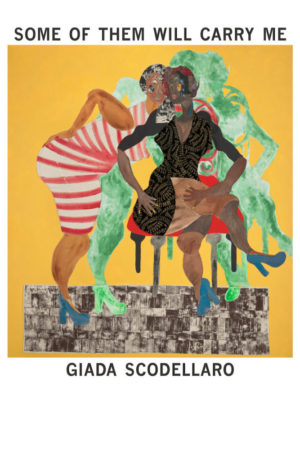Some of Them Will Carry Me
by Giada Scodellaro
reviewed by Jackie Thomas-Kennedy
In these brief, visually rich, often fable-like stories, Giada Scodellaro establishes a striking and unpredictable voice. A yellow kitchen wall has thoughts and senses, observing the life of the house’s occupants. To describe a relationship between a woman and a child, Scodellaro writes, “There had been placenta between them.” A recipe for gnocchi urges the reader not to be “lazy.” Thumbs are repeatedly described as having an odor (of tobacco, of cigarettes). The narrator of “A Triangle” forms the titular shape by noticing a couple in the street and deciding to watch them, then admits: “If I followed the couple home it was because of her hair.” The defiant defensiveness of this sentence prepares the reader for work that will be both alarming and playful, pastoral and disturbing.
In “A Triangle,” the narrator is positioned as a greedy voyeur. Twice, watching the couple through a window, the narrator observes the man’s hand on the woman’s neck. First, she comments on “his hand wrapped around her neck like a scarf”; then, several paragraphs later, “his beautiful hand on the neck of the woman, her eyes shut, and her dark eyebrows reaching up in mild surprise.” The narrator then turns inward, inserting themselves into the scene, and imagines being under another’s gaze: “I don’t know how long she stayed like that, unmoving, but we must have been a sight to see.” Scodellaro’s work creates numerous possible readings, complicated further in this story by the narrator twice comparing the people they watch to inanimate objects: “Hers was a plain face, really, as unremarkable as a piece of furniture”; later, “skin” is described as “like a burnt chair.” Earlier, a burnt chair abandoned in the street had prompted the narrator to tell us, in a parenthetical note, that “men expect things to have violent ends.”
Several of these stories appear to build toward moments of violence or confrontation, but the narratives change direction and wander elsewhere. Scodellaro’s work is particularly drawn to ambiguity. In “Freedom of White Boys in the Sand,” a boy knocks a girl into the dirt. The story calls him “responsible” for her fall, and notes that, when he attempts to help her up, “he really was no help at all.” Tension builds on the page as onlookers wait to see what they will do. They become a “new pair,” and go home together, where they each find the other’s stories tedious. Neither love nor revenge is present—rather, the story ends with dull domesticity.
Sentient kitchen walls first appear in “Freedom of White Boys in the Sand,” and they surface again in “The Misconduct of Sand, and the Seven.” The two are companion pieces, though the occupants of the house have changed. “The large tree outside their home was infused with remnants of a bicycle,” Scodellaro writes in “The Misconduct of Sand, and the Seven.” In the earlier piece, “Freedom of White Boys in the Sand,” the pair ride to the house together on a silver bicycle.
Scodellaro’s work shows an interest in texture and earth, in the way sand shifts and clings, the way it follows people home through their clothes and their bodies. In “Spalding,” Jazmynn and her partner “enjoyed not only the land but also its absence,” embodied by a
large hole next to the house, muddy and emptied. A steamboat had been excavated from it [ … ] The excavators who dug up the steamboat [ … ] allowed Jazmynn and her partner to choose one object to keep for the trouble of having a large hole dug into their empty land. The rest would be stored in a white man’s museum.
Jazmynnn makes a choice, but it holds no great value for her. When her partner leaves her, she gathers the belongings he left behind (canned food, a basketball) and sleeps next to them. These become treasures.
Scodellaro repeatedly explores the value of objects, particularly in “Spalding.” When a woman visits Jazmynn, now living alone in the house, “they continued discussing the importance of objects—how they tether us and how sometimes they help to create connections, but also how they can be meaningless garbage.” These stories experiment with both the connective object and the “garbage.” In one of the finest pieces, “540i,” the title of the story itself refers to an object—specifically, to the BMW car Bruna is taking through a car wash. As the water flows and the car gets washed, Bruna changes, taking on different names and qualities, altering the way she’s wearing her hair. It is a wonderful series of transformations that mirror the act of writing and revising, of surveying the options and making a choice, as Scodellaro has done here in this superb collection.
Published on January 31, 2023

